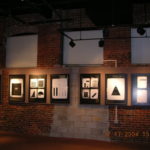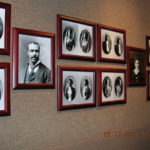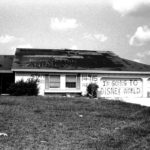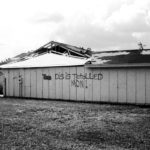Websites/Photographic Exhibits/Slideshows
Over the years I have created extensive visual archives. Several became the basis for exhibits. Primarily documentary in nature, they include strong aesthetic elements. They include the following:
-
The Exhibit of American Negroes
-
The Signs of Andrew
-
Jesse Wooley’s Florida Adventure
-
Visual Sources in the History of American Education
The Exhibit of American Negroes is a reconstruction of highlights from an exhibit of the same name put together by W. E. B. DuBois, Thomas Calloway and the Historic Black Colleges for the Paris 1900 International Exposition. The original exhibit included thousands of photographs, as well as hundreds of books, pamplets and assorted documents chronicling the experience of African Americans up to the year 1900.

The materials included in this reconstruction represent an overview of one of America’s great collections of African-American history. Drawn primarily from materials in the Library of Congress, It was assembled over a twenty-five year period. Besdies presentations at national conferences, the research outcome of the project was several articles, a book,an exhibit and a omprehensive website. After recently retiring from the University of Miami, the website for the project was removed from the university’s server. I plan to restore the site to a private server in the next few months.
Roman and Littlefield published a history of the exhibit in 2013.

An exhibit of many of the photographs and statistical charts were exhibited in 2004 at Atlanta’s Apex Museum in Atlanta, Georgia. The Apex Museum is among the main African-American history museums in the South.
Photographs of the exhibit are included below.
 Click on the gallery to see larger versions of the photographs.
Click on the gallery to see larger versions of the photographs.
|
[Click on the different images on the collage to see full pictures.] |
||||||
The Signs of Hurricane Andrew
Over the past forty years the names of many of the suburban housing developments that have sprung up in the southern part of Miami-Dade County, Florida have been romantic and nostalgic. Names such as Panache, Dorothy’s Place (referring to the main character in the L. Frank Baum’s The Wizard of Oz), Forest View, Silver Palm Estates and Country Walk, are intended to evoke an image of the good life with occasional hints of glamour and even fantasy. In the case of the “Country Walk” complex, the image promoted by its builder, the Arvida Corporation (now owned by the Walt Disney Corporation) was of a warm, sharing place with a village center, friendly shops and schools, and pleasant bicycle and walking paths. It was a place you would want to raise your kids and quietly grow old. Despite the nostalgic image presented by its builder, during the mid-1980s early 1990s Country Walk had more of the quality of a nightmare about it than the American Dream. In 1985, Francisco Fuster, who ran a daycare center in the complex, was convicted of 14 counts of child abuse bringing unwanted national attention to the development. On August 24, 1992 Hurricane Andrew struck South Florida. Country Walk was among the most seriously damaged communities by Hurricane Andrew. Much of the blame for the destruction of Country Walk was placed on the Arvida Corporation. Inspections after the storm indicated that roof braces for many of the houses were sloppily attached and that the gable ends widely used throughout the complex were particularly vulnerable to high winds. Arvida took the position that the building code under which the houses were built was no match for the storm. The psychological and emotional impact of Hurricane Andrew on the people of Country Walk is evident in the signs the members of the community spray-painted on their homes after the storm. Spray painting messages on the side of a building is more commonly associated with urban youth gangs than with middle-class suburbanites. Many of the spray-painted signs that appeared not only in Country Walk, but across the South Florida community after Andrew, provided a means of connecting with an insurance company or with loved ones and friends after the storm. Some signs included an insurance company’s name and a policy number for the house on which it was sprayed. Often this information was accompanied by a message to a friend or relative. “HART WE ARE ALIVE!” was the message sprayed on the garage door of one house, while next to the front door, in large letters, was the policy number for the homeowner’s insurance. Other signs on houses included both humorous and angry comments about the situation. A painted palm tree decorated a sign that said “LIFE BEGINS AFTER ANDREW.” Next to it was sprayed “ARVIDA SUCKS!!” a reference to the Arvida Company’s motto. A similar sign simply stated “SURVIVED ANDREW! GOOD LUCK ARVIDA WELL BUILT.” One sign advertised a house being for sale “RE-DESIGNED—DECORATED—LANDSCAPED BY HURRICANE ANDREW INCORPORATED.” Another announced that the house on which it was painted was “PROTECTED BY SMITH AND WESSON.” A skull and crossbones suggested that looters would be dealt with harshly. A sign on S. W. 147th Street showed a comic figure with its tongue sticking out. The accompanying message was, “YOU LOOT WE SHOOT.” Many of the messages included as part of the signs at Country Walk, such as “WE BEAT ANDREW!!” demonstrated the determination and grit of the survivors of the storm. Others suggested how the storm may have directed people towards spiritual and religious reflections. “JESUS SAVES!” was scrawled on the side of more than one house. Some of the signs quoted Scripture. On a wall just a few feet away from a public health sign that declared the house unfit for human habitation, was a sign which proclaimed: “AND HIS ANGELS ENCAMPED AROUND THOSE WHO LOVE THE LORD.” On a house on 141st Place, printed over the front door in large block letters, was the message “GOD STALKS YOU INTO DEEP WATER NOT TO DROWN YOU BUT TO TEACH YOU HOW TO SWIM.” Just a few feet away, on a broken gutter pipe, waved an American flag. The messages included on the signs in Country Walk represent a wide-range of personal responses to Hurricane Andrew and the destruction it brought to the South Florida community. They reveal not only the personal strength and spirit of their creators, but also their anger against inadequate building codes and construction. As a collection, they represent an important and unique commentary. The collage included above includes photographs of many of the signs on homes in Country Walk that appeared after Hurricane Andrew. By clicking on the sign you can link to the photograph where the sign is documented.
|
||||||

Late in January of 1896, Jesse S, Wooley, a well=known photographer from Ballston Spa, New York, took passage on the S. S. Algonquin. In Florida, he created a stereopticon or lantern-slide lecture about the “Sunshine State.” Wooley subsequently returned to Floida in the 1920s and 1930s–once again documenting what he saw with his camera. The photographs and text that make up the following website /photo exhibit are the result of his trips in 1896 and three decades later.
Jesse Wooley’s Florida Adventure
http://scholar.library.miami.edu/wooley/index.html
http://scholar.library.miami.edu/andrew/html/signs_of_andrew.html



























